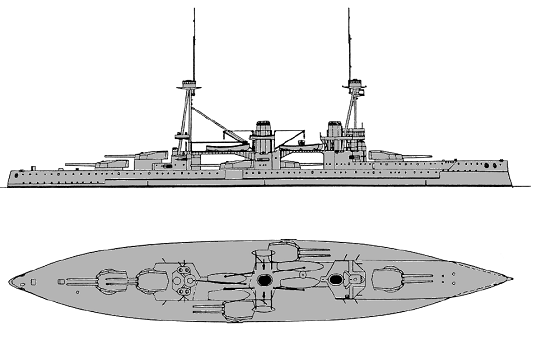
NAVYPEDIA
 Support the project with paypal
Support the project with paypal
Photo

Neptune 1911
Ships
| Name | No | Yard No | Builder | Laid down | Launched | Comp | Fate |
|---|---|---|---|---|---|---|---|
| Neptune | 02, 89, 79 | Portsmouth DYd | 19.1.1909 | 30.9.1909 | 1/1911 | sold for BU 9.1922 |
Technical data
| Displacement normal, t | 19680 |
|---|---|
| Displacement full, t | 22720 |
| Length, m | 166.4 |
| Breadth, m | 25.9 |
| Draught, m | 8.70 max |
| No of shafts | 4 |
| Machinery | 4 Parsons steam turbines, 18 Yarrow boilers |
| Power, h. p. | 25000 |
| Max speed, kts | 21 |
| Fuel, t | coal 2710 + oil 790 |
| Endurance, nm(kts) | 6330(10) |
| Armour, mm | belt: 254 - 64, bulkheads: 203 - 102, turrets: 280 (face) - 203 (sides and rear) - 76 (roof), barbettes: 229 (over main deck) - 127 (under main deck), deck: 76 - 19, CT: 280 (face and sides) - 203 (rear) - 76 (roof) |
| Armament | 5 x 2 - 305/50 BL Mk XI/XII, 16 x 1 - 102/50 BL Mk VII, 4 x 1 - 47/40 3pdr Hotchkiss Mk I, 3 - 450 TT (2 beam, 1 stern) |
| Complement | 759 |
Standard scale images

Neptune 1911

Neptune 1917
Graphics
Project history
To 1910 British dreadnoughts could fire 8 guns on the broadside, whereas American Delaware class could fire 10 and Argentinean Moreno 12 guns. The solution chosen for the first ship of the 1908 Programme was far from satisfactory, but it was a step in the right direction. The wing turrets were staggered to give a limited degree of cross-deck firing, and to avoid too long a hull, 'X' turret was raised a deck level over 'Y' turret, as on USN ships. Cross-deck firing proved of limited value as it strained the hull, but the new layout did at least permit 10 guns to be fired on the broadside. Unfortunately axial firing from the wing turrets caused unacceptable damage to the superstructure, and the superimposed turret could not fire directly aft because they concussed the gunlayers in 'Y' turret. The exposed positions for 102mm guns on turret roofs were abandoned, and all the secondary guns were mounted in the superstructure. To keep the arcs for 305mm guns clear the boats were carried on a prominent 'flying bridge', but it was soon recognised that these were likely to be destroyed by gunfire, with the inevitable consequence that the wreckage would foul the guns below. For the first time cruising turbines were provided, to cut coal consumption at slow and medium speed. Neptune was the fastest British battleship to date, making 22.7kts on trials.
Protection
Main belt has 254mm (tapering to 203mm at the lower edge) thickness between barbettes "A" and "Y", 178mm between barbette "A" and stem (last 10m part from the stem was 64mm), 64mm between barbette "Y" and stern; its height was 2.08m. Upper belt over 254mm main belt was 203mm. Both belts closed by fore 127mm and after 203mm bulkheads. Second fore 102-127mm bulkhead was at the end of 178mm belt. Main deck was 32mm between barbettes "A" and "Y", 44mm middle deck with 44mm slopes closed citadel. Lower deck was 76mm aft from barbette "Y" and 38mm fwd from barbette "A". Outer sides of barbettes "P" and "Q" were 254mm. Funnel uptakes had 25mm splinter protection.
Modernizations
1912: raising of fore funnel.
1914: removing of fwd flying bridge.
1915: - 1 - 450 TT (stern)
1916: adding of clinker screen to the fore funnel, enclosing of 102mm guns by light steel structures, aft fire control platform was removed
1917: + 2 x 1 - 76/45 20cwt QF Mk I
Naval service
Neptune collided with a merchant ship in April 1916 without serious damages. Paid off 1919.
 HOME
HOME FIGHTING SHIPS OF THE WORLD
FIGHTING SHIPS OF THE WORLD UNITED KINGDOM
UNITED KINGDOM NEPTUNE battleship (1, 1911)
NEPTUNE battleship (1, 1911)
